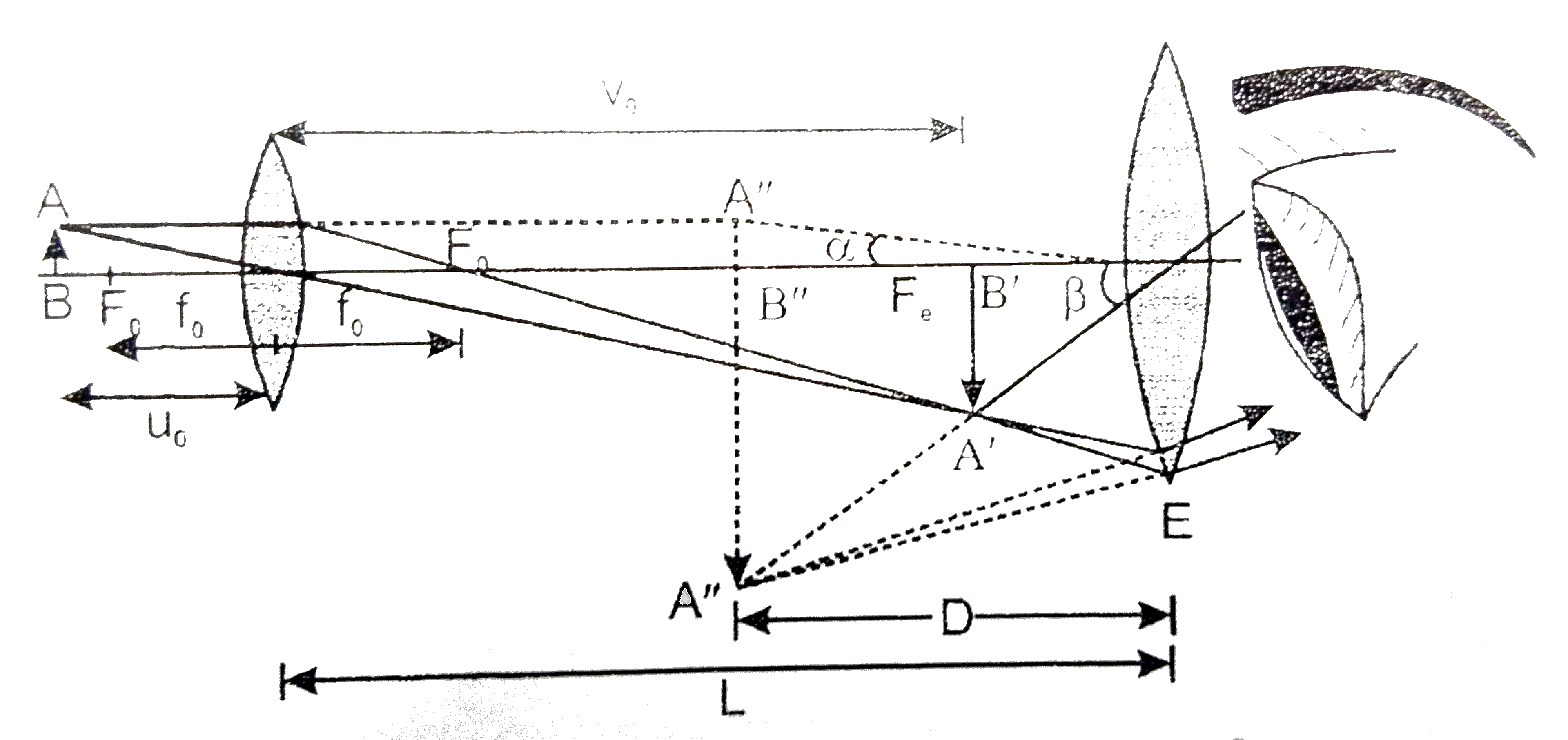Draw a ray diagram to show the working of a compound microscope. Deduce an expression for the total magnification the final image is formed at the near point.
In a compound microscope , an object is placed at a distance of 1.5 cm from the objective of focal length 1.25cm. if the eye piece has a focal length of 5 cm and the final image is formed at the near point, estimate the magnifying the power of the microscope.
Ray diagram for a compound mucroscope

Total angular magnification, m=βα
β→ Angle subtended by the image
α→ Angle subtended by the object
Since α and β are small,
tanα approx α and tanβ approx β
m=tanβtanα
tanα=ABD
And
tanβ=ABD
m=tanβtanα=ABD×DAB=ABAB
On multiplying the numerator and the denominator with A'B', we obtain
m=AB×A'B'A'B'×AB
Now, magnification produced by objective, m0=A'B'AB
Magnification produced by eyepiece, me=ABAB
Therefore,
Total magnification, (m)=m0me
"image distance for image produced by objective lens")/("Object distance for the objective lens")<br>m_(e)=(1+(D)/(f_(e)))<br>f_(e) rarrFocal≤n>hofeyeπece<br>m=m_(0)m_(e)<br>=(v_(0))/(u_(0))(1+(D)/(f_(e)))<br>v_(0) approx L(Separationbetweenthe≤nses)<br>u_(0) approx-f_(0)<br>therefore m=(-L)/(f_(0))(1+(D)/(f_(e)))<br>u_(0)=-1.5 cm<br>f_(0)=+1.5 cm<br>(1)/(f_(0))=(1)/(v_(0))-(1)/(u_(0))<br>(1)/(1.25)=(1)/(v_(0))-(1)/(1.5)=(100)/(125)-(10)/(15)=(1500-1250)/(1875)<br>(1)/(v_(0))=(250)/(1875)<br>v_(0)=+7.5 cm<br>f_(e)=+5 cm<br>m=(v_(0))/(u_(0))(1+(D)/(f_(e)))=(7.5)/(-1.5)(1+(25)/(5))=-(7.5)/(-1.5)xx6<br>m=-30.
Topper's Solved these Questions
- GEOMATRICAL OPTICS BOOK - RESONANCECHAPTER - GEOMATRICAL OPTICS EXERCISE - Advance level Problems
35 Videos
- GEOMATRICAL OPTICS BOOK - RESONANCECHAPTER - GEOMATRICAL OPTICS EXERCISE - Exercise-2
63 Videos
- EXPERIMENTAL PHYSICSBOOK - RESONANCECHAPTER - EXPERIMENTAL PHYSICSEXERCISE - PART -II
10 Videos
- GRAVITATIONBOOK - RESONANCECHAPTER - GRAVITATIONEXERCISE - HIGH LEVEL PROBLEMS
16 Videos
Similar Questions
(a) Draw a ray diagram to show the working of a compound microscope. Deduce an expression for the total magnification when the final image is formed at the near point.
(b) In a compound microscope, an object is placed at a distance of 1.5 cm from the objective of focal length 1.25 cm. If the eyepiece has a focal length of 5 cm and the final image is formed at the near point, estimate the magnifying power of the microscope
View SolutionThe focal lengths of the objective and the eyepiece of a compound microscope are 1.0 cm and 5.0 cm respectively. An object, placed at a distance of 1.1 cm from the objective, has its final image formed at a distance of 25 cm from the eye. Find the magnifying power of the microscope.
View Solution
Knowledge Check
The two lenses of a compound microscope are of focal lengths 2 cm and 5 cm. If an object is placed at a distance of 2.1 cm from the objetive of focal length 2 cm the final image forms at the least distance of distinct vision of a normal eye. Find the frnagnifying powerjof the microscope
A20B6C120D60An astronomical telescope has an objective of focal length 100 cm and an eye piece of focal length 5 cm. The final image of a star is seen 25 cm from the eyepiece. The magnifying power of the telescope is
A20B22C24D26In a simple microscope of focal length 5cm final image is formed at D, then its magnification will be
A6B5C2D1
A compound microscope with an objective of 1.0cm focal length and an eye piece of 2.0cm focal length has a tube length of 20cm. Calculate the magnifying power of microscope is final image is formed at the near point of eye.
View SolutionFor a compound microscope, the focal length of eyepiece and objective lens is 5 cm and 1 cm, respectively. The length of the tube is 30 cm. If the final image is formed at infinity, calculate the magnifying power of the microscope.
View SolutionIn an astronomical telescope, focal length of eye piece is 5cm and focal length of objective is 75cm. The final image is formed at the least distance of distinct vision (=25cm) from the eye. What is the magnifying power of the telescope ?
View SolutionA microscope is having objective of focal length and eye piece of focal length 6cm. If tube length 30cm and image is formed at the least distance of distant vision, what is the magnification prodcut by the microscope. (take D=25cm)
View SolutionA compound microscope has an objective of focal length 2.0cm and an eye-piece of focal length 6.25cm and distance between the objective and eye-piece is 15cm. If the final image is formed at the least distance vision (25cm), the distance of the object form the objective is
View Solution
